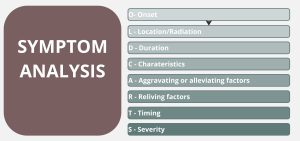Abdominal System
Summary – Abdominal System
The abdomen can be mapped out by dividing it into four quadrants or nine regions. Clear understanding of the organ structures, their functions, and blood and nerve supply are required to assess gastrointestinal disorders and analyze patient signs and symptoms specific to the various anatomical regions of the abdomen.
The abdominal cavity is covered with a serous membrane called the peritoneum. The cavity and its contents (organs) are supported by four main pairs of muscles and nourished by specific vascular structures. The structures of the abdomen are responsible for the processes of digestion and human reproduction making abdominal symptom etiology multifactorial and complex.
Abdominal pain is the most common presenting patient concern of the abdominal system. A mnemonic such as OLD CARTS is a valuable symptom analysis tools that assist health care professionals to collect information about a presenting symptom in the patient’s own words.

Organs of Each Abdominal Quadrant
| Right Upper Quadrant (RUQ) | Left Upper Quadrant (LUQ) |
| Duodenum Gallbladder Liver Head of the pancreas Right kidney Right adrenal gland Hepatic flexure of colon Part of ascending and transverse colon |
Left lobe of liver Stomach Spleen Body of the pancreas Left kidney Left adrenal gland Splenic flexure of the colon Part of the transverse and descending colon |
| Right Lower Quadrant (RLQ) | Left Lower Quadrant (LLQ) |
| Cecum Appendix Part of ascending colon Right ovary and fallopian tube Right ureter Right spermatic cord |
Part of descending colon Sigmoid colon Left ovary and fallopian tube Left ureter Left spermatic chord |
| Midline | |
| Aorta Uterus Bladder |

